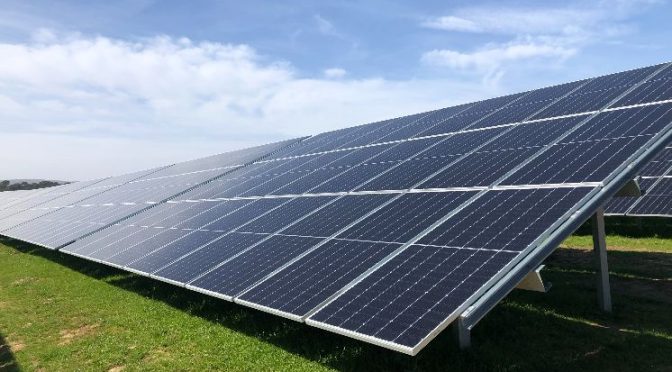Like impacts from other weather and environmental forces (e.g., hail, wind, snow, wildfires), flood damage can often be prevented or at least mitigated through simple, no- to low–cost measures. The following technical recommendations can be added to project specification requirements of a new system or used to assist in planning for a modification to an existing solar PV system.
This webpage covers flooding topics related to on-site ground or elevated systems (e.g., solar PV canopies) for both new and existing systems. Though the lessons learned may also be applicable to utility-scale (large) systems, this content focuses on topics related to smaller on-site systems.
Even in severe cases such as large coastal floods from hurricanes, these mitigation measures can reduce the amount of damage that results from a severe flood event. In some cases, mitigation measures can make the difference between a total loss versus repairable damage.
Assessing a Site for Flooding Risks
A site can be flooded from a nearby coastal area, stream, river, or lake overflowing onto neighboring lands. Flooding also occurs when a high rate of precipitation (downpour) inundates the ability of the site to absorb the stormwater creating large areas of standing water.
A site does not need to be within a known flood plain (e.g., as defined by the Federal Emergency Management Agency, FEMA) to experience flooding. FEMA floodplain maps cover flooding from coastal and inland bodies of water (e.g., rivers, lakes, streams) but not from stormwater inundation. A site will need to be assessed using both FEMA flood maps and through the use of local information.
Use the resources below to understand the flood risks of a proposed solar system. Make adjustments to the proposed system to avoid any obvious areas that are of high risk for flooding.
Coastal and Riverine Flooding
Utilize the FEMA flood mapping tool
by inputting the site’s address and adjusting the zoom level to reveal the color-coded areas and symbols on the map. Within these maps, users will find many codes and symbols, but three key pieces of information are most relevant to a proposed solar site:
- 100-year flood level: A 100-year flood zone means that in a given year there is a 1% probability that a site will flood. This may sound like a low risk but consider that over a 25-year timeframe, there is a 22% probability, which is significant.
- 500-year flood level: A 500-year flood zone translates into an annual probability of 0.2%, or 4% over 25 years.
- Base flood elevation (BFE): The BFE is the 100-year flood level measured as feet above sea level.
Predicting future flood risks from sea-level rise & changing rainfall patterns
It is very difficult to predict what flood risks may be present on a site during a PV system’s 25-30-year life. For coastal areas, the NOAA Sea-Level Rise Viewer tool
| can be used to estimate future flooding from sea level rise. The tool is easy to use and requires a street address or the name of a city and state. Make sure to click on “high-tide flooding” where the map displays areas that will be flooded in the future from the combined effects of sea-level rise and high tides. |
Stormwater Inundation
During a rainstorm, the ability of the soils to absorb and drainage systems to move water becomes overwhelmed causing a large amount of standing water. This is a common phenomenon and can occur at any site. Some sites are known to be vulnerable to stormwater inundation where standing water is often spotted during and after rainstorms.
As shown by the Photovoltaic Stormwater Management Research and Testing (PV-SMaRT) study
, ground treatment and cover under the array field may reduce the ability of the site to absorb stormwater. This occurs from common ground treatment methods used with solar PV ground systems. Though this study focused on large utility-sized systems, some of the key discoveries are most likely applicable to the kinds of smaller ground systems found on federal sites.
| Solar PV Modules Classification in Some StatesSome states define the surface area of the module as impervious while others provide an exemption. For new projects, the PV-SMaRT study |
| (see Table 2 on page 11) provides a summary of states that have standards to address solar PV systems and groundwater management. |
Measures To Prevent Flood Damage
Inspections of flooded sites reveal opportunities to reduce or even eliminate the damage and thus reduce recovery costs and time following a flood event. Agencies can implement measures (many low-cost) to mitigate or prevent damage to both proposed and existing systems.
Structural Engineering Measures
Electrical Engineering Measures
Additional Measures
Additional Resources
Toward Solar Photovoltaic Storm Resilience: Learning from Hurricane Loss and Rebuilding Better
General Services Administration Explores Solar Photovoltaic Storm Resilience After Hurricane Damage
Severe Weather Resilience in Solar Photovoltaic System Design
Solar Photovoltaics in Severe Weather: Cost Considerations for Storm Hardening PV Systems for ResilienceSolar Photovoltaic Systems in Hurricanes and Other Severe WeatherPreparing Solar Photovoltaic Systems Against Storms
Quick Links
Optimizing Solar Photovoltaic (PV) Performance
Distributed Energy Resources for Resilience


